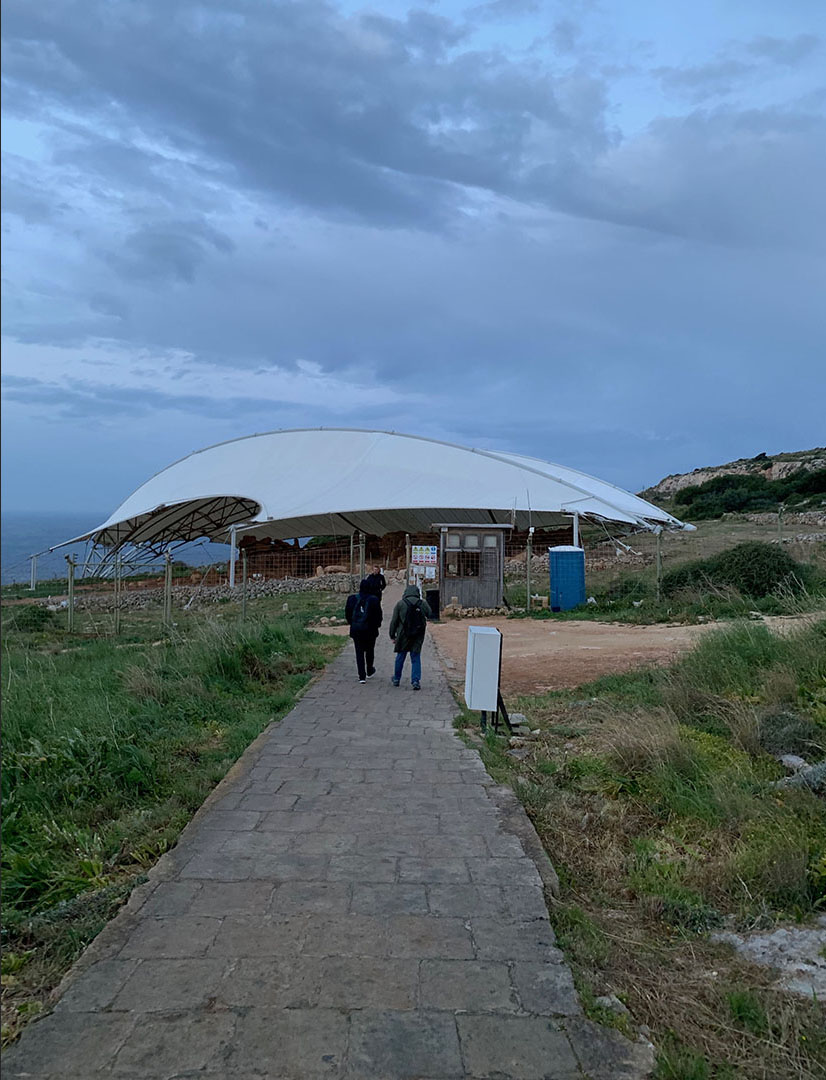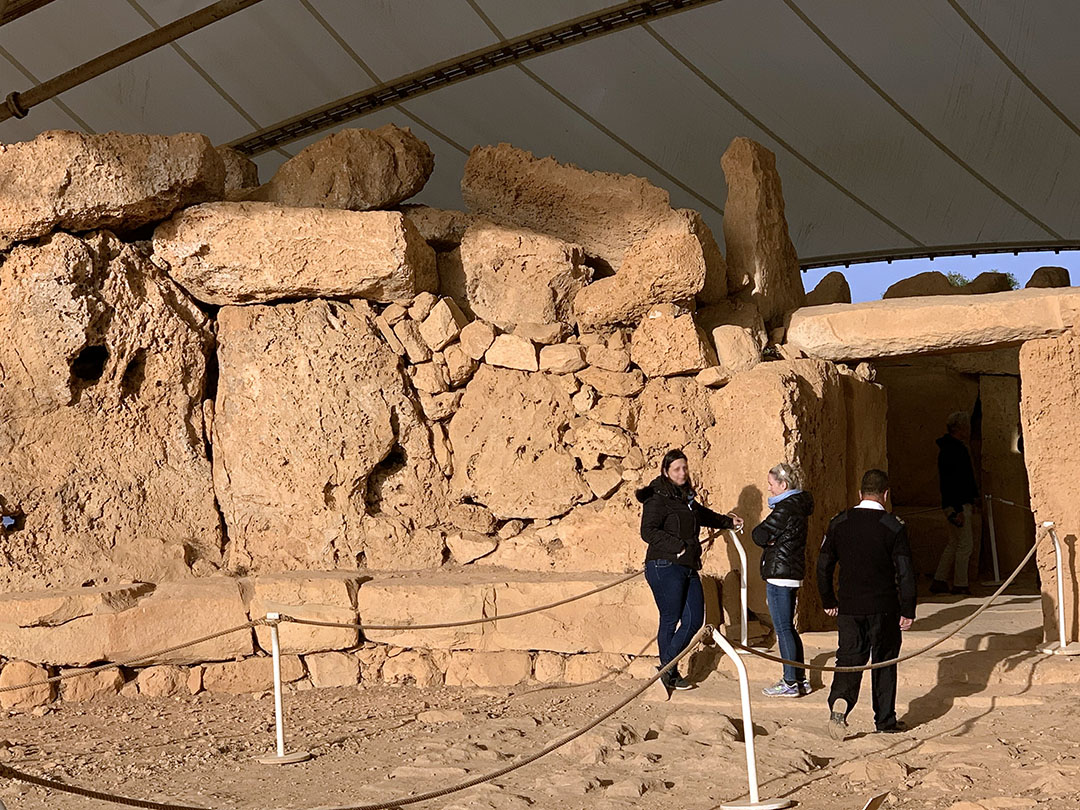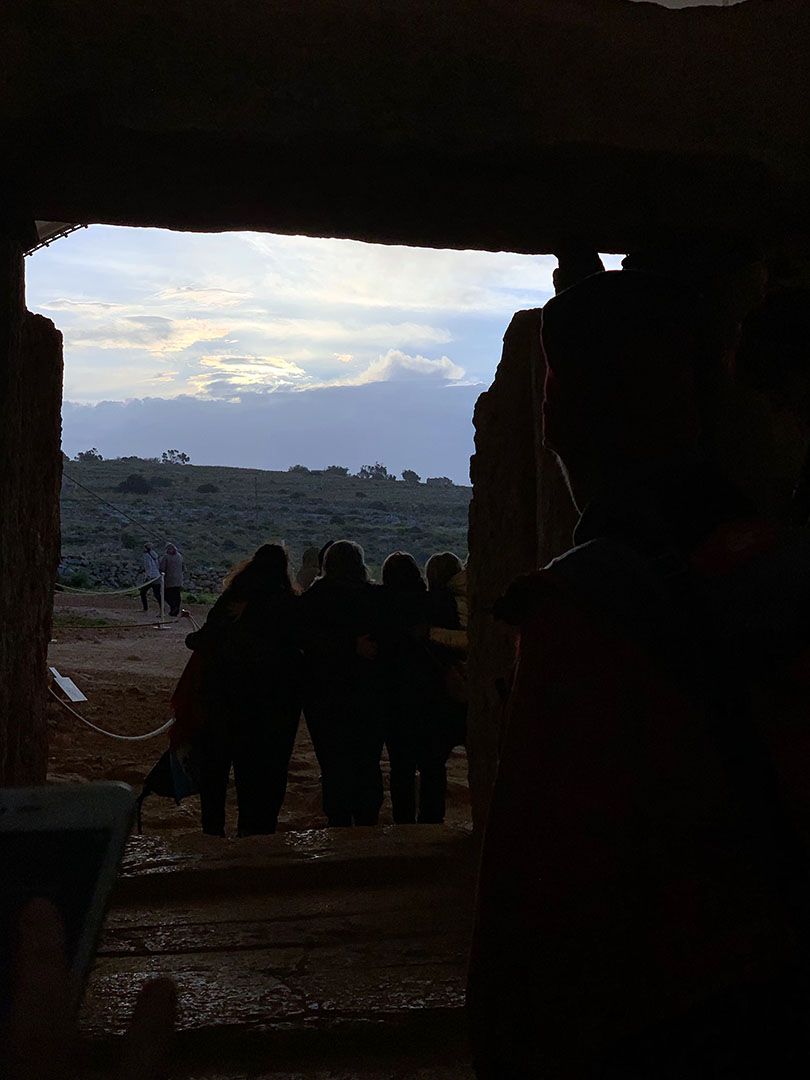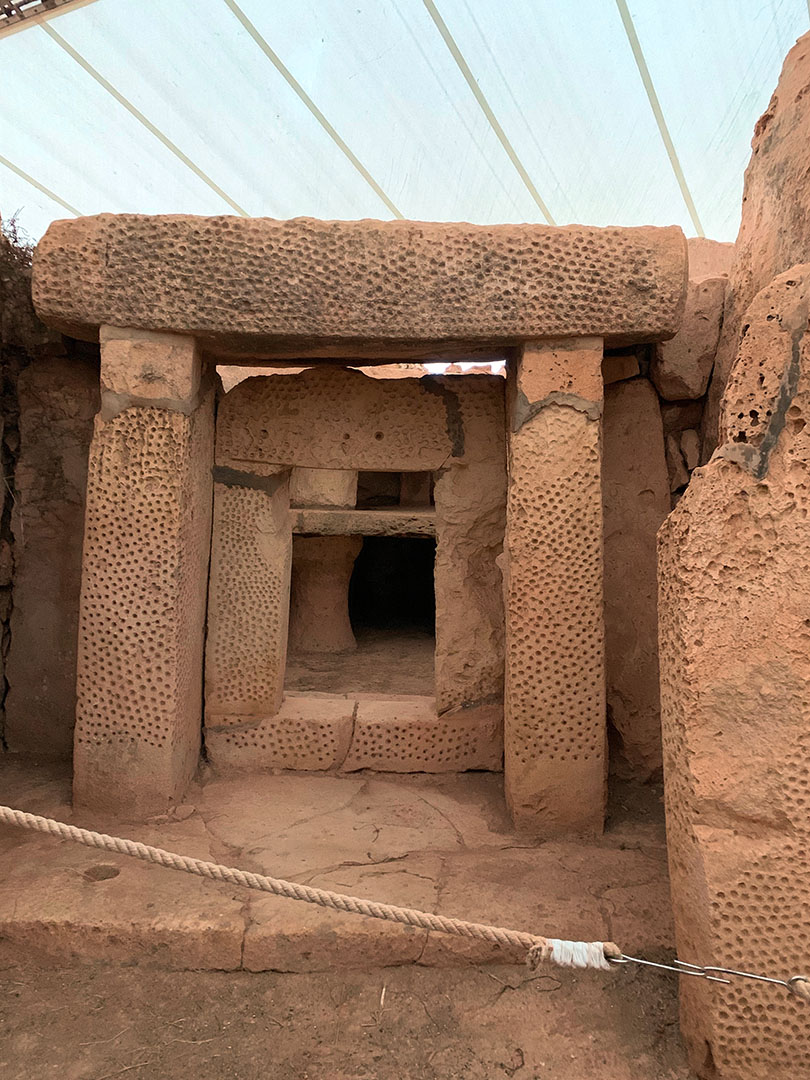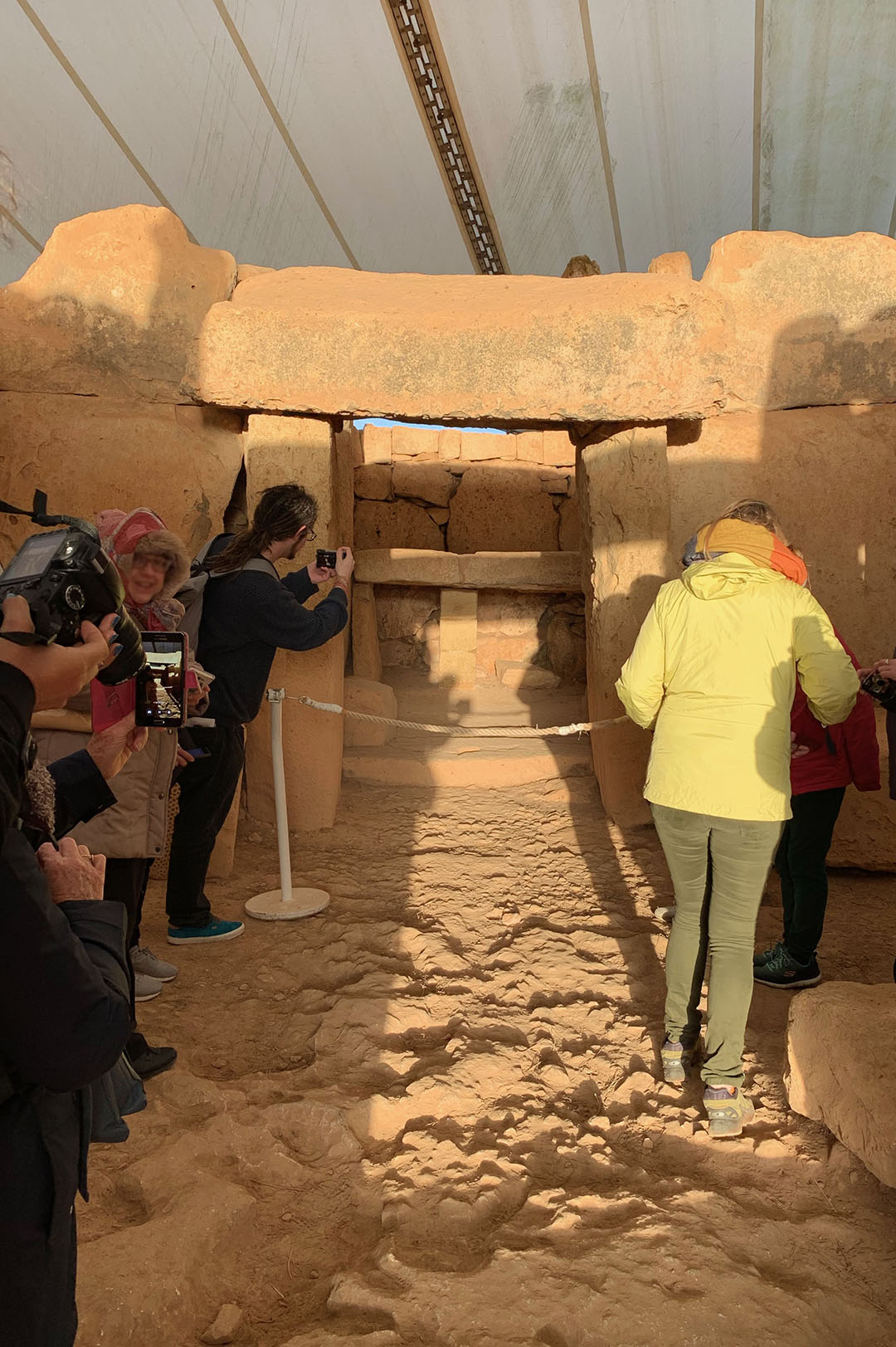Demystifying Malta
By Elyn Aviva
Gary (my husband) and I arrived in the dark, joining the drips and dribbles of other visitors being deposited at the entrance to the Visitors’ Center by a mixture of taxis, private cars, and mini-vans. Some thirty in all, we huddled in small groups in the pre-dawn chill, waiting to be told we could leave the shelter of the Center and walk the ¼ mile path to the 5,500-year-old Mnajdra Temple. It was getting worrisomely late. The sun was due to rise in only 15 minutes. If we weren’t allowed to leave soon, we’d miss the equinoctial sunrise event.
Much to our astonishment, we saw Maria and Carol, two old friends from Cornwall, standing in a corner with four other women. We greeted each other enthusiastically. They were leading a group of Goddess-celebrating women to sacred sites on Malta. We marveled at the synchronicity that brought us together at 5:45 am on Malta at the Visitors’ Center on this blustery, chilly morning of the spring equinox, the day when day and night are in equal balance.
As we waited, I overheard bits of conversation. A group of six Italian pagan women were buzzy with excitement; two Japanese photographers; another small group included a National Geographic videographer, an academic historian of pre-Christian Mediterranean religions, and an author whose most recent publication was a study of the astronomical associations coded into the architecture at Mnajdra. Maria and Carol’s group eagerly discussed their forthcoming experience of the Goddess, whose rotund shape they believed was expressed in the 5-lobed interior floorplan of the temple.
“Entering the temple will be like entering into the body of the Goddess,” one of them confided to me.
Eavesdropping on these chatting groups, I began to wonder about my own motivation for being here. A few weeks before, sitting in my study in Oviedo, Spain, I had felt called to go to Malta to see the equinox sunrise at Mnajdra. I wanted to experience an event that had first been celebrated almost 6,000 years ago. I wanted to somehow connect with the ancient Maltese who had lived so long ago and created this impressive megalithic temple. That desire was strong enough for Gary and me to return to Malta, a place we had visited several times in recent years.
At last the guard gestured we could go to the temple, and everyone started walking—some quickly, some slowly—to the nearby entryway. We waited impatiently while the gate was unlocked and swung open. Then another guard took our tickets, and we started walking down the paved path to Mnajdra. The official guide/temple guardian strolled leisurely behind.
In the dim light I could see the temple outlined against the sky, its huge limestone walls shaded by the billowing white canopy that protected it from the weather. I was in a hurry, so I left Gary behind and trotted down the path. I wanted to be first in line—or at any rate near the front of the line—in the temple to watch the spring equinox sunrise shine down the central corridor and light up the stone altar at the far west end.
I reached the temple and was the first to walk in. Much to my surprise, rope barriers now excluded me (and other visitors) from some of the apses to which I had had access a few years before and from approaching too close to the altar.
“Never mind,” I thought, “At least I can see the altar and the path of the sun.”
The official guide was in no hurry to enter. In fact, he stood outside the temple, with the majority of visitors gathered around him, expounding on the history and archaeology of Mnajdra. I watched in consternation. What about the equinoctial sunrise? Wasn’t that what we were here to experience? He droned on outside, as if determined to keep this event “informational,” without even a shred of actual “felt” experience.
I, on the other hand, sat down on a large flat stone inside the first apse in the temple. I admired the randomly incised dots in the golden limestone uprights. They seemed to form shifting, curving patterns, and I wondered if they were an ancient consciousness-altering device. I closed my eyes and sank into a light trance, which was soon disturbed by chitter-chattering voices. Three women had come into the temple, and from beneath my almost-closed eyelids I watched them take selfies of themselves and perform some kind of invocation, which one of them videotaped.
The sky was getting lighter. By now it was 6:20 am, 15 minutes after the sun was supposed to rise. I stood up and looked outside. The guide and the group were now facing a distant hilltop. As we watched, a sliver of brilliant sunlight broke through the morning mist. Soon the sun had pushed itself above the hill, and a beam of light began to make its way through the entrance of the temple, down the corridor, to light up the top of the stone altar. It flowed like liquid gold, warming the honey-colored limestone walls until the glowed.
People flowed into the temple as well, and soon the corridor was lined several-deep with people taking cellphone shots of the event, and of themselves witnessing the event—an event that had been celebrated here for the first time thousands of years ago. The rumble of voices sank down to a gentle murmur. People knew they were witnessing something spectacular.
To be part of this—to be witness to this event—was a blessing. It was also bizarre. In ancient times, there would have been some kind of ceremony, some kind of recognition of Spirit or Deity or something—some communal ritual affirming the repetitive patterned rhythm of sun and planet, of day and night. This morning, however, there was not a hint of Spirit or ceremony or community. The official guide continued to expound information, explaining the details of the event as if it were a science experiment.
I’m sure his incessant patter was intentional, a way to stave off any unwelcome expression of modern-day pagan ritual. A way to de-mystify and disempower what was once a sacred event. Instead of greeting the sun in awe and celebration, people greeted it with chatter and selfies.
Self-righteously, I wondered what the Maltese priests would think if they could see us now.
An officious guard strolled into the temple and told everyone to be sure not to touch any of the stones—and not to sit down, either. I was glad he hadn’t been there earlier. With a sigh, I walked out, looking for silence amidst the hubbub.
I reminded myself that everyone was excited to see the sun’s rays strike the altar. That counted for something. And all these people had gone to great inconvenience to get up early and travel to see this event—surely that must signify something. Maybe it wasn’t spiritual, but maybe it was—I don’t know, an inkling? A longing to experience something “more”? A desire to be part of an historical event? After all, was my motivation really so much different?
I strolled back to entrance of the temple and noticed Maria, eyes closed, lips moving, in a trance, not quite leaning against the left side of the stone entryway. She seemed surrounded by a golden light. After a while, she opened her eyes and smiled.
“That was amazing,” she whispered. “I received the blessing of the Goddess. I could feel Her enter into me as I did my meditation.”
Surprised, I asked, “You weren’t bothered by all the chatter and noise?”
She spoke softly, as if returning from far away. “What chatter?”
While I had been busy judgmentally critiquing the general lack of spirituality and being disturbed by the noise, Maria had had an experience of the Sacred. There was an important lesson there for me. Perhaps that’s what I had come to Mnajdra to learn.
Elyn Aviva is a transformational traveler, writer, and fiber artist who lives in Oviedo (Asturias), Spain. She is co-author with her husband, Gary White, of “Powerful Places Guidebooks.” To learn more about her publications, go to www.pilgrimsprocess.com and “Elyn Aviva Writes” on Facebook. To learn about Elyn’s fiber art, go to www.fiberalchemy.com. Elyn’s latest novel is The Question – A Magical Fable.

